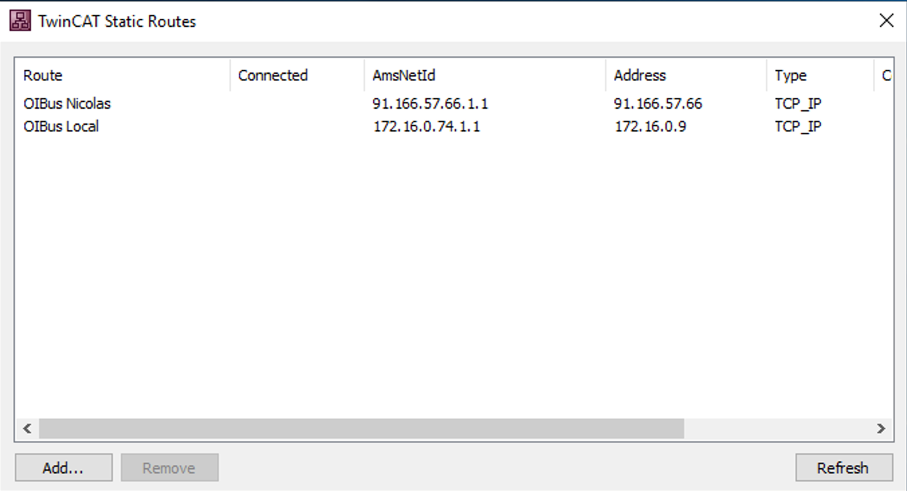ADS - TwinCAT
The ADS protocol (Automation Device Specification) is a transport layer within TwinCAT systems, developed by Beckhoff.
Each data item is referenced by a unique address within the controller and can be accessed by OIBus with the ADS connector.
OIBus uses the ads-client library.
Connection settings
The AMS Router is the entity which connects ADS clients (OIBus) to PLCs and TwinCAT runtime. This allows OIBus to access PLCs data.
Depending on the AMS Router location, several setups are possible.
With local TwinCAT runtime
When TwinCAT is installed on the same machine as OIBus, the ADS connector can use the same TwinCAT runtime and directly communicate with the PLC, with its Net ID and ADS Port.
The Net ID is an IP-like address with two additional numbers. Usually, the Net ID is the IP address on which the PLC is
addressed from the network, with two additional numbers to address the appropriate PLC (several PLCs can be accessed
from one AMS Router), for example 127.0.0.1.1.1.
The port is the one used to contact the PLC from the AMS Router (by default 851).
With remote ADS server
For a remote ADS server, the Net ID and the ADS Port are still required, and other fields are needed:
- Router address: the IP address (or domain name) of the AMS router
- Router TCP port: the port used by the AMS router
- Client AMS Net ID: a client identifier used to identify a connection with the TwinCAT runtime.
- Client ADS port (optional): the port used by the client to exchange data. If empty, it is given randomly by the AMS server. If filled, be sure that the port is not used by another client.
TwinCAT runtime must accept the communication from the ADS connector. To do so, Static Routes must be added in the TwinCAT Static Routes tool. The following example accepts two routes whose AmsNetId is to be used on the OIBus side. It is important that the AmsNetId is used through the IP address specified.

Only one remote ADS connector can be set for OIBus. If two ADS connectors are needed to connect two PLCs, use a local ADS server (available by default if OIBus is installed on the same machine as the TwinCAT runtime).
Data settings and structures
Points list
The ADS connector retrieves values from specific addresses. These can be added in the Points section (in the upper right corner).
In this list, points can be added with:
- Point ID: the address of the data in the targeted PLC (example:
GVL_Test1.TestINT) - Scan mode: the request frequency. To define more scan modes, see Engine settings.
Data settings
PLC name
In the case where data from similar PLCs (sharing the same point addresses for example) are retrieved from two ADS connectors and sent to the same North, the values will have the same point ID even though they come from two different PLCs.
To avoid this ambiguity, the PLC name can be added in front of each point ID once the data is retrieved. In this way, the point IDs sent to the North connector will be differentiated.
If PLC1 has for PLC name PLC001. (the dot is included in the name) and the point ID is MyVariable.Value, the resulting point ID once the values are retrieved will be PLC001.MyVariable.Value and this will allow to identify the data in a different way than the PLC2 which will have a resulting point ID of PLC002.MyVariable.Value.
Enumerations and booleans
An enumeration can be retrieved as an integer or as a character string (the PLC knows both thanks to its programming).
A boolean value can be retrieved as an integer or a string (with 0 = false,1 = true).
Structures
It is also possible to query an entire data structure. For example, if the data MyVariable is of type MyStructure and has the following fields:
- MyDate
- MyNumber
- Value
And if only MyDate and MyNumber must be retrieved, then, in the ADS structures section a new structure can be added with the name MyStructure, and in the fields part, only the two fields can be specified, separated by commas: MyDate,MyNumber
This is especially useful when several data (here MyVariable) are of type MyStructure, and only a few fields of the structure are requested (here MyDate and MyNumber). The more fields the structure has, the more useful this feature is.
In the end, each field will give a unique resulting point ID. In the previous example, this will give for the single point MyVariable the following two points:
- MyVariable.MyDate
- MyVariable.MyNumber